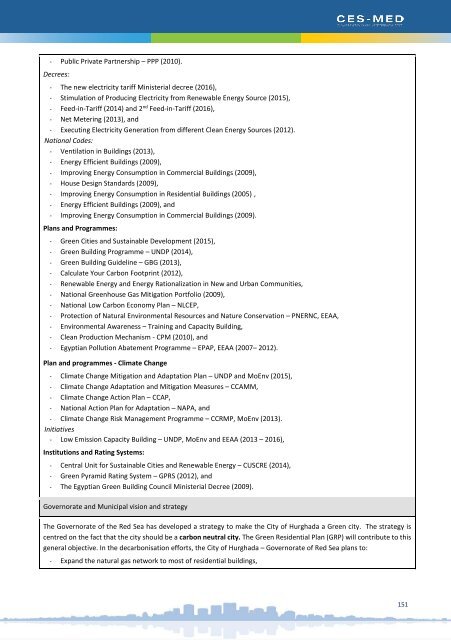020318_Hurghada SECAP_FINAL
You also want an ePaper? Increase the reach of your titles
YUMPU automatically turns print PDFs into web optimized ePapers that Google loves.
- Turn off electric equipment at the end of working time or when not actually in use, and<br />
- Unplug all electricity cables from wall’s sockets as this could save about 5 per cent of the energy use,<br />
- It would be interesting to promote a challenge between services/units to invite all workers from the<br />
Governorate to make efforts to save energy and cut GHG emissions. The best performing service would be<br />
celebrated as “energy saver/ climate saver’’ and would get a special gratification.<br />
- The Environmental Awareness Unit (EAU) to be set up within the Governorate to promote these activities in<br />
coordination with the Governorate related staff.<br />
Component 2: Beyond promoting awareness and behavioural change, it is necessary to develop a clear and<br />
comprehensive plan to replace old devices and equipment and install energy efficient systems that will help reducing<br />
electricity consumption. Ideally, this programme should be implemented, in a first phase, in a small number of buildings<br />
(starting with the more symbolic one: the main Governor’s building or city hall), but covering all type of devices and<br />
equipment, in order to concentrate many initiatives on the selected buildings and demonstrate the benefit of these<br />
structural changes:<br />
- Switch from AC/ Heating reverse systems to central management of heating and cooling.<br />
- Switch to LED lighting installation and incorporate motion sensors in offices of Governorate buildings. This<br />
device turns the lights off during un-occupied periods. This can reduce lighting consumption by 20% to 80%<br />
depending on the occupancy type of these spaces.<br />
These technical solutions need to be tightly monitored to register impacts on energy consumption reduction to prepare<br />
progressive enlargement to a larger number of targeted building.<br />
Assumptions:<br />
- 1 LED Lamp costs 75 EGP (3.60 €) and reduces lighting consumption by 70%<br />
- A Solar PV unit of 1KW costs 1,300 €) and produces 1898 kWh/y.<br />
- According to Egyptian Electricity Transmission Company (EETC), the Feed in Tariffs for 2017 are as follows:<br />
• 108.58 piasters (0.053 €) per 1kWh for commercial activities less than 500 kWh,<br />
• 7.88 piasters (0.004 €) per 1 kWh from Solar PV power plant 500 kW to less than 20 MW.<br />
Switch to LED lamps and sensor systems: Assuming a replacement of 20,000 LED lamps in Governorate buildings<br />
including schools (70 buildings), i.e., on average 275 LED lamp per building, we would need 72,000 € for replacing<br />
conventional lamps by LED. This switch will result in saving of 364 MWh/y and 199 tCO2eq/y.<br />
Switching to more efficient AC devices: Switch from AC/Heating reverse systems to central management of<br />
cooling/heating in these buildings is estimated at 150,000 €. This will result in saving 546 MWh/y and 299 tCO2eq/y.<br />
Solar Water Heating (SWH) systems: Basic assumption: a 300 litres production unit with three collectors offering 6.75<br />
square meters’ produces 5 MWh/y. With a basic cost of € 582 while substituting to electricity the payback period will<br />
be 40 months (3 years + 3 months).<br />
A rough calculation for one Governorate building with 100 staff and 25 visitors a day on average would need 2,500<br />
litres per day of hot water (20 litres per person). Such needs can be covered by 8 SWH units (300 litres and three panels<br />
- 2.50m x 0.9m each) requiring a total surface of 55 square meters at a cost of 8 x € 582 = € 4,656.<br />
This equipment will produce 50,600 kWh/y to be substituted to electricity consumption saving 28 tCO2eq/y.<br />
Considering additional equipment and connection to the water grid the overall cost for such a building would be 5K€.<br />
Applying this model to 10 Governorate buildings, the required investment would be 50,000 € allowing a production<br />
capacity equivalent to 500 MWh/y. Hence, avoiding a cost of 370 kEGP (17.620 €/y), meaning a return on investment<br />
143

















